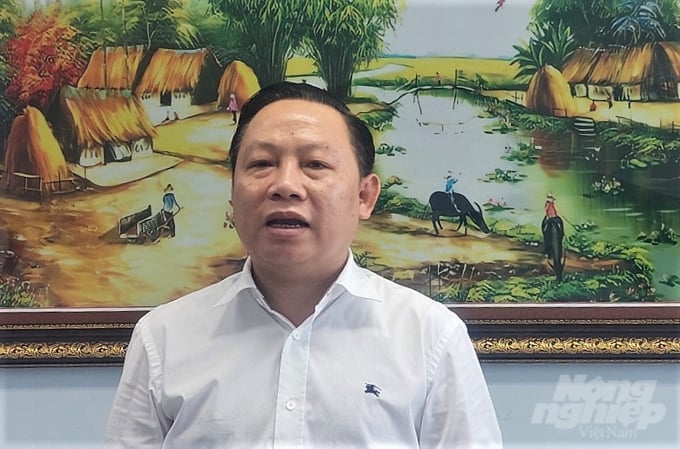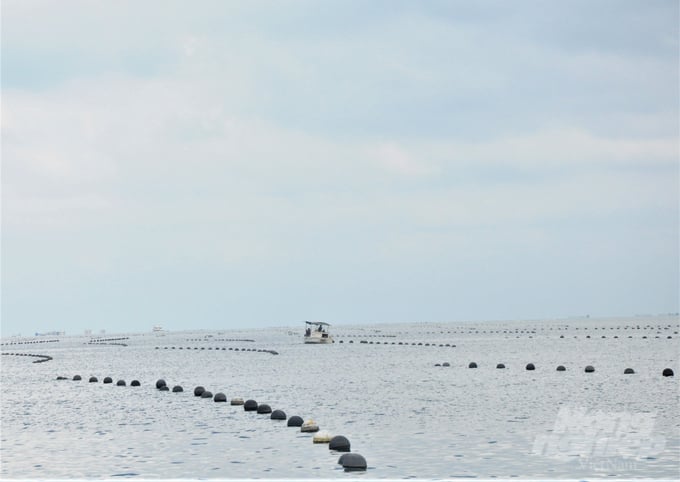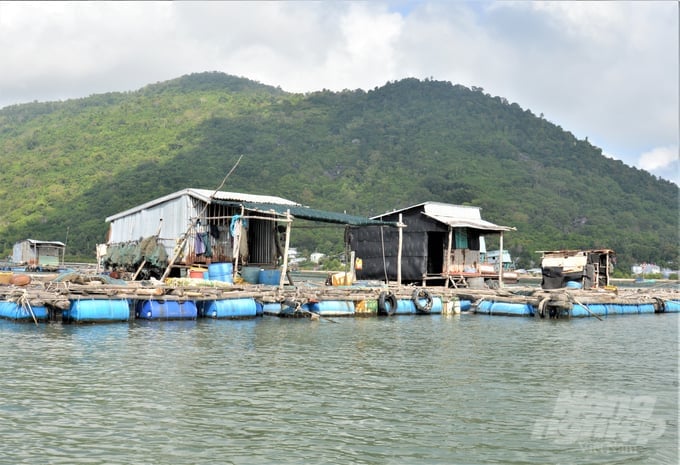May 16, 2025 | 10:30 GMT +7
May 16, 2025 | 10:30 GMT +7
Hotline: 0913.378.918
May 16, 2025 | 10:30 GMT +7
Hotline: 0913.378.918

Le Huu Toan, General Director of Kien Giang province's Department of Agriculture and Rural Development. Photo: Trung Chanh.
Regarding the challenges and obstacles in the development of mariculture in Kien Giang province, Vietnam Agriculture Newspaper had an interview with Le Huu Toan (pictured), General Director of Kien Giang province's Department of Agriculture and Rural Development. Kien Giang possesses substantial potential and advantages for mariculture; however, it faces numerous challenges in practical implementation.
Kien Giang has a vast marine area, with hundreds of large and small islands. It is often regarded as a key province for fisheries exploitation and aquaculture in Southern Vietnam. Could you please share on the current development status of the province's fisheries sector and its contributions to the socio-economic landscape?
Kien Giang's fisheries sector is a comprehensive economic sector encompassing inland, marine, and island activities in exploitation, aquaculture, seafood processing for export, and fisheries logistics services. The sector has achieved encouraging growth and made significant contributions to the province's socio-economic development in the last few years.
Kien Giang boasts the largest fleet of fishing vessel within the country, consisting of over 8,000 registered vessels, including 3,634 offshore fishing vessels. The province's total aquaculture area spans over 290,000 hectares, with nearly 4,000 marine fish cages. The total annual output from both fisheries exploitation activities and aquaculture is estimated at approximately 800,000 tons, with fisheries exploitation accounting for nearly 435,000 tons.
The province houses over 200 businesses specializing in preliminary processing and seafood processing, including 25 large-scale seafood processing and exporting businesses with advanced production technologies, capable of meeting the requirements for exporting seafood to international markets.
The average total production value from the province's fisheries exploitation and aquaculture activities in the years between 2021 and 2023 reached approximately 32,860 billion VND. During this period, the province's seafood export revenue averaged over 250 million USD, which is equivalent to approximately 6,000 billion VND.
Through fisheries exploitation, aquaculture, and seafood export activities, more than 200,000 unskilled workers in the province have found employment, including over 70,000 offshore workers, who contributed significantly to the province's economic development and social stability.

The challenges in allocating marine surface areas to businesses for project implementation are significant obstacles to the development of mariculture. Photo: Trung Chanh.
To promote sustainable fisheries development, Kien Giang province has planned to restructure its fleet of fishing vessel and exploitation activities, reduce fishing intensity, and enhance aquaculture to maintain output levels. What policies has the province implemented to encourage and support fishermen in the transition from fisheries exploitation to aquaculture?
Kien Giang province hosts a large fleet of fishing vessel; and excessive exploitation has led to an imbalance between fishing intensity and the ability to regenerate aquatic resources. Consequently, the province has been restructuring and reorganizing its fleet and exploitation activities over the years to gradually reduce the total number of fishing vessels, with a focus on nearshore vessels and vessels utilizing destructive fishing practices that harm the ecological environment. In 2024, the province plans to reduce its seafood catch volume by 45,000 tons compared to the previous year's plan.
To compensate for the decrease in catch volume, the province has supported fishermen in transitioning from fisheries exploitation to aquaculture, particularly high-tech mariculture. Additionally, the province focuses on logically exploiting and utilizing marine surface potential to restructure its fisheries sector, with an emphasis on the effective and sustainable balance between fisheries exploitation and aquaculture. This initiative involves gradually reducing the total number of fishing vessels; decreasing pressure from exploitation activities; increasing the scale, productivity, and output of mariculture; maintaining food safety standards; creating employment opportunities; and improving the income of coastal communities.
On the other hand, the province is promoting fisheries extension activities; supporting fishermen in transitioning from fisheries exploitation to mariculture; and converting traditional wooden cages into high-tech HDPE cages for offshore mariculture. Furthermore, the province conducted various training programs to promote the transition from using naturally caught trash fish as feed to industrial pellet feed for marine fish, with the goal of protecting aquatic resources and reducing environmental pollution.
The province has developed a Sustainable Mariculture Development Plan until 2030, with a vision towards 2045. Could you please outline the objectives of this plan?
Kien Giang has identified the marine economy as the primary development direction for the immediate future, with a focus on the efficient and sustainable development of industrial and modern mariculture. Accordingly, the province has approved the Sustainable Mariculture Development Plan until 2030, with a vision towards 2045, to encourage fishermen to develop mariculture activities and utilize marine resources.
The plan targets a total cage mariculture area of 16,000 hectares by 2030, with 14,000 mariculture cages. Similarly, the mollusk farming area is targeted to reach 25,000 hectares. On the other hand, mariculture output is expected to reach approximately 207,200 tons by 2030, including 105,700 tons from cage mariculture and 101,500 tons from mollusk farming, with pearl production reaching 520,000 pieces. The mariculture sector is projected to create jobs for nearly 48,000 local workers.
The plan encompasses mariculture zones in Phu Quoc city, Kien Hai Island district, Tien Hai Island commune, Ha Tien city, Son Hai Island commune, Hon Nghe Island commune, and Kien Luong district. Primary cage farming species include grouper, cobia, golden pompano, barramundi, and various other aquatic species such as spiny lobster, mantis shrimp, crabs, and pearl oysters.
Coastal areas, including Ha Tien city and the districts of Kien Luong, Hon Dat, An Minh, and An Bien, will prioritize the farming of mollusks such as blood cockles, suberenata ark, sea mussels, green mussels, undulated surf clams, oysters, among others.
The implementation of the Mariculture Development Plan has contributed considerably to the province's economic growth, employment market, and provided livelihoods for the local community. Additionally, mariculture plays an indispensable role in reducing fishing pressure, regenerating aquatic resources, and mitigating conflicts in resource protection, thereby contributing to the sovereignty and security of Vietnam's maritime territories.

Fishermen in Kien Giang typically build their own mariculture cages using wood, which has low durability and poor resistance to waves, rendering the cages suitable only for inefficient nearshore aquaculture. Photo: Trung Chanh.
Kien Giang province recently granted investment policies in the field of mariculture to major corporations and businesses. However, why have these projects not been implemented in practice? What are the challenges and obstacles in their implementation?
Following investment promotion conferences and the announcement of the provincial planning for Kien Giang in the years between 2021 and 2030, with a vision towards 2050, multiple businesses have received investment policies in the field of mariculture, with a total registered marine surface area of over 2,600 hectares. Beneficiaries include major corporations and businesses with sufficient economic and technological capabilities; they are often considered leaders in modern and high-tech mariculture.
However, our current challenge lies in the unapproved National Marine Spatial Planning and the Comprehensive Plan for the Sustainable Use of Coastal Resources. In addition, the procedures for allocating specific marine areas for resource exploitation and use under Decree No. 11/2021/ND-CP dated February 10, 2021, requires the involvement of various ministries and departments, which resulted in numerous obstacles in the allocation process. As a result, the province is unable to carry out the allocation of specific marine areas for cage mariculture in compliance with regulations.
This is a major barrier to the development of mariculture in Kien Giang, which has also prevented many businesses from implementing their projects despite their investment policies.
Furthermore, the current local infrastructure for mariculture is limited. Central and local efforts to improve the infrastructure for mariculture has failed to match the development pace of the mariculture sector.
In addition to encouraging and attracting businesses to invest in mariculture, local governments must focus on addressing the challenges and obstacles in the investment procedure process. Namely, stakeholders should facilitate the implementation of projects belonging to major corporations and businesses that have received investment policies from the province. This initiative will contribute to the economic and social development of the province's coastal and island areas; and effectively implement the strategy for the sustainable development of Vietnam's marine economy by 2030, with a vision towards 2045.
Translated by Nguyen Hai Long

(VAN) Cold-barn systems efficiently manage environmental and temperature conditions, which aids in the prevention of respiratory diseases in pigs and protects them from the vectors that transmit African swine fevers.

(VAN) To tackle challenges, the project 'Addressing key technical bottlenecks in the grouper supply chain in Vietnam' has been underway since 2024.

(VAN) The project 'Disease-Resilient and Sustainable Cassava Production Systems in the Mekong Region', funded by the Australian Center for International Agricultural Research (ACIAR), is being implemented from 2024 to 2028.

(VAN) Data from 10,000 farming households will help professionalize production organization and support the implementation of the One Million Hectares Program for High-Quality, Low-Emission Rice Cultivation.

(VAN) FAO Director-General QU Dongyu marks International Day of Plant Health at NENA conference.

(VAN) Deputy Minister of Agriculture and Environment Hoang Trung affirmed that floriculture and ornamental plants are a growing industry that receives significant global attention.

(VAN) The three staple crops dominating modern diets – corn, rice and wheat – are familiar to Americans. However, fourth place is held by a dark horse: cassava.